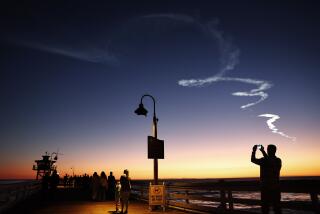Scientists cite growing peril of space junk
ST. LOUIS — A successful Chinese missile test last year that destroyed one of China’s own aging satellites has substantially added to space debris around Earth, increasing the danger that a chain reaction of colliding space junk could threaten parts of the world’s satellite network, scientists said Tuesday.
The threat is that debris could begin slamming into other debris, creating a cascading effect called supercriticality, according to scientists addressing the American Physical Society conference here this week.
“Debris in space is already a problem,” said David Wright, a senior scientist with the Union of Concerned Scientists in Cambridge, Mass. “But it’s potentially a very big problem.”
Geoffrey Forden, an MIT physicist and expert on the Chinese space program, said the danger from space debris was actually more of a worry than the threat that the Chinese, or some other country, could intentionally cripple American space assets with antisatellite weapons.
Forden argued that America’s redundancy in space satellite systems made it almost invulnerable to that kind of attack, and that it would be relatively easy to spot the Chinese readying a launch.
On the other hand, he said, “We are in danger of a runaway escalation of space debris.”
According to Wright, the Chinese shoot-down on Jan. 11, 2007, added more than 2 million pieces of debris in low-Earth orbit, where most satellites are located.
Because there is already so much debris -- more than 150 million pieces, most of them less than 2 inches across -- even if nothing more is added, the amount will still increase by a factor of three in the next 200 years due to the fragmentation of pieces from collisions and other reasons.
That could be a low estimate if more antisatellite tests take place. Destruction of a single 10-ton satellite could contribute as many as 15 million pieces of junk, thousands of them more than a foot across.
Even now, a satellite orbiting Earth passes within 60 miles of a piece of junk several thousand times a day and has a 1% chance each year of getting hit.
“Space is not a big, empty place,” Forden said.
In February, the U.S. demonstrated its own antisatellite capability, shooting down a dead spy satellite. But that didn’t pose the danger of the Chinese test because the U.S. satellite was in a low enough orbit -- 125 miles up -- that the debris will soon burn up in Earth’s atmosphere.
The Chinese missile struck a satellite orbiting 530 miles above Earth, meaning the debris will remain in space for hundreds of years, the scientists said.
Still, Forden called the Bush administration decision to shoot down its satellite “bad policy” because it could encourage other nations to build their own antisatellite weapons.
The U.S. began to recognize the threat from space junk about a decade ago, Wright said. Since then, it has been taking measures to reduce the amount of new debris. Those efforts had largely succeeded until the Chinese demonstration.
Forden said the threat of supercriticality was a warning that it was time to treat space not as a vast junkyard, but as a natural resource that must be protected the same way we were learning to protect resources on Earth.
“We’re fortunate we haven’t really screwed things up yet,” Wright said. “But the Chinese test brought home how quickly this could get out of hand.”
--
More to Read
Sign up for Essential California
The most important California stories and recommendations in your inbox every morning.
You may occasionally receive promotional content from the Los Angeles Times.










